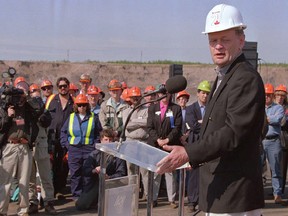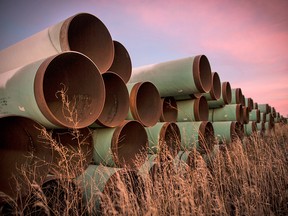How Canada Wins: ‘We need to understand again how blessed we are to have such big resources’
Article content
One June day in 1996, three years after he became prime minister, Jean Chrétien made his way to a recreation centre in Fort McMurray, now the gritty northern Alberta heart of the oil sector, sitting atop the world’s third-largest oil reserves.
Article content
Article content
The Liberal prime minister, along with oilpatch workers and executives and provincial leaders, signed on to a “Declaration of Opportunity,” heralding an era of energy expansion and wealth for Alberta and Canada.
Advertisement 2
Article content
“It was a time when the country saw the oilsands as a huge opportunity to create wealth,” Richard Masson, then the director of oilsands policy and development for the Alberta government, told National Post in an interview. “We need to understand again how blessed we are to have such big resources.”
Nearly three decades later, as the United States kicks off a trade war with Canada, the national conversation has turned to protecting the Canadian economy and how, in the case of the energy sector, we preserve national prosperity while shifting away from the United States — the single largest buyer of Canadian oil.
For the past decade, Alberta — and its oil sector — have been in something of a melancholic haze, as multiple pipeline projects failed, energy companies cancelled major projects and the price per barrel on occasion slumped to less than the cost of a pint of beer.
Yet Alberta’s oil sector is producing more oil than ever before. In November 2024, Alberta’s oil producers pumped nearly 132 million barrels of oil out of the ground. That’s almost double the monthly production of Alberta’s oil sector during the latest boom years (2013-2014). And while employment is down from those years, there are still some 85,000 people employed by the energy industry compared to the 71,000 who worked in the sector in 2001.
Advertisement 3
Article content
A weakened price for oil — currently at about US$63 — and the difference between prices for Alberta’s oil and the Texas blend used as the benchmark eats into corporate profits. That makes the ability of Canadian producers to get products to market quickly and cheaply, normally by pipeline, all the more important.
As Masson sees it, we can start with a bit of an attitude shift, remembering the enthusiasm of the 1990s and collectively — across provincial borders, political parties and levels of government — cheering on resource development.
“We have an opportunity here. It’s huge. We’re good at it. We can be leaders in addressing climate change, and then be a secure, reliable supplier of energy to the world,” Masson said.

In the weeks since U.S. President Donald Trump, the possibility of building new energy infrastructure has taken on fresh urgency. Nova Scotia Premier Tim Houston, for example, has called for the proposed Energy East pipeline to the East Coast to be revived, and called Bloc Québécois leader Yves-François Blanchet’s opposition to the project “appalling.”
Article content
Advertisement 4
Article content
Alberta Premier Danielle Smith, who laid out Alberta’s response to the Trump tariffs on March 5, suggested multiple potential routes for a new pipeline, including a revived Energy East that would bypass Montreal. She also suggested restarting the process to build Northern Gateway, which would have terminated in Kitimat, B.C., or a spur line running from somewhere along the existing Trans Mountain pipeline to northern British Columbia.
She also noted several other possibilities, including an eventual pipeline shadowing the long-planned Grays Bay port and road project, which would connect the far north of Nunavut to Yellowknife, N.W.T., and a pipeline connecting Alberta and B.C. to Hudson Bay for export or perhaps a spur line running from a southern Canadian pipeline up to James Bay.
There is little private sector interest, however, in initiating or resurrecting those projects without significant changes to the Canadian regulatory regime and commitments from government that the projects are guaranteed.
“We would need to see real legislative change at the federal and provincial government levels that specifically identifies major infrastructure projects, like Northern Gateway, as being in the national interest and therefore legally required,” Enbridge CEO Greg Ebel said recently.
Advertisement 5
Article content
There is considerable demand for oil internationally. Last week, BP, one of the largest oil and gas companies in the world, announced that it was pivoting away from renewable and green energy to focus on petroleum, just two years after its former CEO told a Houston energy conference that the company was moving away from being an international oil company.
Sonya Savage, Alberta’s former energy minister, said that for the past decade, Canada’s energy policy has been subsumed by its climate policy. That, she argued, needs to change.
“It’s an ideological agenda that’s been developing over the last 10 years,” Savage said. “If we’re going to signal that we want to be an energy superpower, that we want to increase production, that we want to have a strong economy, we have to completely pivot away from the whole ideological agenda of the last 10 years.”
Because we have the third-largest reserves in the world, we have a responsibility, in a global context, to think about how we’re going to develop that energy
There are issues that are cited, again and again, as limiting factors in Alberta’s oil expansion that proponents say must be addressed.
The first, the Impact Assessment Act, the regulatory regime introduced in 2018 by the governing Liberals to approve major projects, was quickly dubbed the “no more pipeline act” by former Alberta premier Jason Kenney. The second, Bill C-48, which brought into law a long-term ban on oil tanker traffic off the northwestern coast of British Columbia. The third, a lack of capacity to transport Canadian oil to ports for export, or, more precisely, a lack of pipelines.
Advertisement 6
Article content
The three have an integrated relationship: the tanker ban, for example, more or less made impossible the Northern Gateway pipeline, which was to run from Bruderheim, Alta., to Kitimat, B.C., because even if it got there, large tankers would have been banned from picking the stuff up for shipment abroad. The strictures of the Impact Assessment Act — the law that Bill C-69 created — make it difficult to even propose a new pipeline or oilsands project, according to critics.
“Because we have the third-largest reserves in the world, we have a responsibility, in a global context, to think about how we’re going to develop that energy,” said Masson. “So, how are we going to develop this resource that we’re stewarding to the best interest of Canadians and to the rest of the world? And I’m not saying there’s one right way, but it’s a question we need to think about. We never think about it that way as Canadians.”
There is at least one major point of agreement on what Canada needs if it’s going to grow its energy sector further and find new markets: pipelines.
“The issue has always been getting to market. So that’s the nut we have to crack as a country. We’re going to build pipelines or, incrementally, companies are going to move more and more by rail,” said Masson.
Advertisement 7
Article content
To move oil by pipeline as opposed to rail is both safer and more cost-effective. If the impact of those two issues can be dampened, oil companies in Canada can expect their product to command a better price and access to different markets. Joe Oliver, who served as natural resources minister under Stephen Harper, said the Trump tariffs have made it all too clear that Canada needs better economic resilience, greater productivity and broader markets.
“And of course to have broader markets and resources, you need infrastructure, pipelines to tidewater,” Oliver said in an interview. “How do you do that? Well, for one thing, you get rid of the hostile regulatory environment and and the hostile policy environment.”

At present, the bulk of Canada’s pipelines run south, to the United States. Efforts to build coastal pipelines — Energy East and Northern Gateway — have been scuppered by a variety of issues, including provincial and Indigenous resistance and a lengthy regulatory regime.
The pipeline question has always been political. Energy East faced considerable opposition in Quebec. Northern Gateway, the Trans Mountain expansion and Coastal GasLink are all controversial in British Columbia. Savage said to build a new pipeline, crossing multiple jurisdictions, it’s going to take a “whole of country effort.”
Advertisement 8
Article content
That could include agreements on economic corridors across the country. It could involve some sort of risk-reward balance. In 2017, when Christy Clark was premier of British Columbia, she laid out five conditions under which the B.C. government would accept pipelines crossing its territory. Among them: some rewards to British Columbia in exchange for shouldering the bulk of the risk of a pipeline or tanker spill. It could include public money or backstopping a project. It could include standalone legislation respecting a particular project, as happened in the 1970s with legislation that created the Northern Pipeline Agency to ensure the construction of a gas pipeline from Alaska.
“It starts with the provinces being at the table and having a discussion and saying, ‘What do we need to get beyond this? What do we need to build a coastal pipeline and get the politics out of the way?’” said Savage.
Nevertheless, it’s a bit of a chicken-and-egg problem: In order to expand production, companies need to know they can get their oil to market. But in order to justify building a pipeline, you need a certain number of companies to pledge a certain number of barrels of oil each day for a certain period of time. Not enough pipeline capacity is a problem, but so is too many pipelines and not enough oil to fill them.
Advertisement 9
Article content
Still, said Savage: “If you build it, they will come.”
Companies might not be planning to amp up production because of the lack of capacity and investors may be skeptical, not just of Canada’s regulatory environment but of the likelihood of a major return on investment.
“Everybody talks about pipelines right now but nobody wants to build one, and probably the only way we’re going to get one built is if the government guarantees returns to some developer, and even then, I’m not sure that’ll be where they want to put their capital,” said Masson.

To invest in an oilsands facility, for example, is a massive undertaking, both in terms of cost and time. This isn’t the old days: you don’t drill a well, suck out the oil over a few years, and move on. An oilsands facility is a decades-long investment, a bet that in 2050 or 2060 there is still going to be a market for Alberta oil.
And investors — the people who at the end of the day approve oil company plans — have been clamouring for dividends in the post-COVID world, not new spending. Andrew Leach, an energy economist at the University of Alberta, argued that investors are preferring to stake their cash on investment cycles of only a few years instead of decades-long investments.
Advertisement 10
Article content
“That’s not what anybody is really investing in as much globally. It’s not just a Canada problem,” said Leach.
Alberta has always been hampered by factors well outside its control. The markets, Leach said, were skeptical that there was going to be enough oil for Northern Gateway, Energy East and Keystone XL. And then with Keystone, the only line still on the table, it was scrapped on the first day of Joe Biden’s presidency in 2021. In 2014, international oil prices collapsed, wounding Alberta’s economy. And now, we’re to some extent at the mercy of the investment decisions of company shareholders.
“We do have some problems, and then we have a lot of people blaming the regulatory process for things that, at least at the current world, were never going to happen,” said Leach. “No one is going to build a new oilsands mine that needs $80 or $90 oil to break even, when oil is not even close to that level.”
Even so, Gitane De Silva, the former CEO of the Canada Energy Regulator, said that the current regulatory environment does lead to investment uncertainty.
“You need to create an environment whereby proponents would have certainty that they could get a project built in a timely way and then start to see return on that investment,” De Silva said.
Advertisement 11
Article content
She suggested, for example, bringing down interprovincial trade barriers that would make it easier for workers to follow projects across the country, or streamline and eliminate duplicative approval processes between provinces or perhaps take political decision-making out of the process altogether. Any of this, she argued, will need to keep Indigenous reconciliation absolutely at the centre of the process if there’s any hope of getting projects built.
She also suggested any regulatory change should include a commitment to let it be for a decade or so.
“You need to take it beyond two election cycles, just given the amount of time it takes for major projects to be built, and then companies to start to see a return on investment,” De Silva said.
If we’re going to signal that we want to be an energy superpower… that we want to have a strong economy, we have to completely pivot away from the whole ideological agenda of the last 10 years
Still, what if the regulatory regime were overhauled?
What if there was a national consensus — or as close to it as possible — that new pipelines and new oil projects were worthwhile? Maybe then the investors, skeptical of these mega-projects, would look twice at Canada.
A major push to rebuild Canadian pride in our energy sector could dampen some of the activism that’s so often identified as a hobbling factor. In fact, polling suggests this might be the time to take a crack at it. An Angus Reid poll from early last month showed that 63 per cent of Canadians believe if more pipeline infrastructure for oil and gas were built it would strengthen the Canadian economy.
Advertisement 12
Article content
“We have this unique moment of time where our country, our confederation, has said we’ve got to get our act together,” said Savage. “We’ve got to be serious about these things…. We have this moment of time, we don’t want to waste it, we don’t want to blow it, we don’t want to miss it.”
Recommended from Editorial
Our website is the place for the latest breaking news, exclusive scoops, longreads and provocative commentary. Please bookmark nationalpost.com and sign up for our daily newsletter, Posted, here.
Article content








